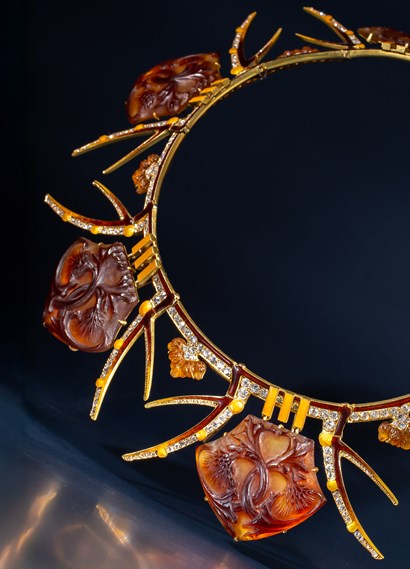This section will be available this Autumn.
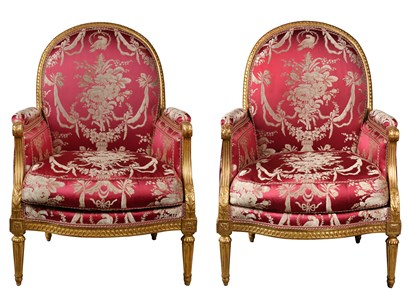
Gallery de Potter d’Indoye
georges jacob
Pair of bergères 'à la Reine' Georges Jacob (Cheny 1739-1814 Paris) France, Louis XVI period Carved and gilded wood H 100 x W 69 x D 61 cm Stamped Georges Jacob Provenance: Jacques Perrin, Paris, 1997 Pair of carved and gilded wood Bergères with rounded backs, decorated with acanthus leaves and an interlacing frieze. Tapered and caned legs with gadroons. The arched crest surmounts padded armrests, the frames carved with guilloche patterns and foliage, resting on turned fluted legs, stamped G. Jacob. Georges Jacob, received as master on the July 5th, 1765, is the most famous of all the 18th-century French menuisiers. Unlike his colleagues, Jacob founded his company from scratch in 1765 and moved his workshops to Rue Meslée in 1775. This is where the most brilliant period of his career took place and where the major royal commissions were produced. From 1773 he was solicited by the Garde-Meuble de la Couronne, for which he continued to work until the Revolution. In addition to the Queen and, to a lesser extent, the King, his clientele included the main members of the royal family and its entourage. As ordinary carpenter to Monsieur, Count of Provence and brother of the King, the future Louis XVIII, he furnished most of his homes. He also worked for the Count of Artois, another brother of the King and future Charles X, Madame Élisabeth, sister of Louis XVI, the Prince of Condé, the Duke of Penthièvre, the Duke of Bavaria and Deux-Ponts Charles-Théodore, etc.
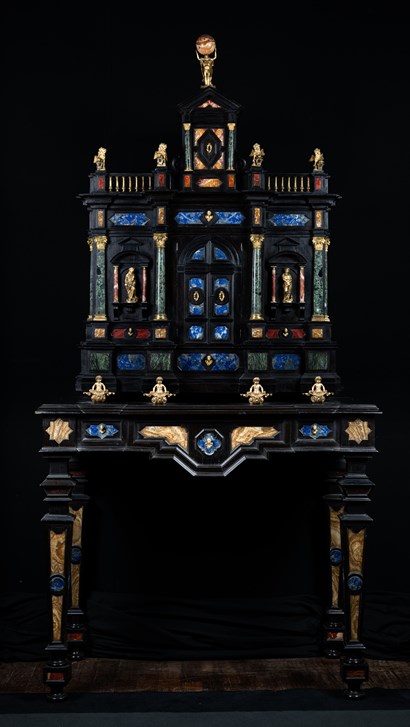
Carlucci Gallery
Roman Cabinat, circa 1780 Ebony veneered, marble and various polychrome stones H 208 x W 105 x D 62 cm Provenance: private collection Cabinet veneered in ebony, marble, and polychrome stones, with an architectural design. The upper section features a tympanum surmounted by Hercules holding the globe in flowering alabaster. A pierced balustrade is crowned with figures of a winged lion bearing a heraldic shield. The façade is articulated with a central door and two lateral doors, each concealing interior disappearing drawers. Materials include jasper, lapis lazuli, breccia, alabaster, and antique green marble.

Galerie des Modernes
mark tobey
Mark Tobey (USA, Centerville, Wisconsin, 1890-1976 Basel, Switzerland) Untitled (Abstract composition) or 'Tout le Monde', 1956 Tempera on paper 20.2 x 24.9 cm Signed and dated lower right 'Tobey 56' The Mark Tobey Project LLC, under the identification n° MT (456-05-15-25). Authentication letter signed by Achim Moeller for Moeller Fine Art Projects dated May 15th, 2025 Provenance: private collection, Belgium Exhibitions: Exhibited at Kunsthalle Basel under n° 0131 (label on back of montage annotated: ‘Tout le monde’)
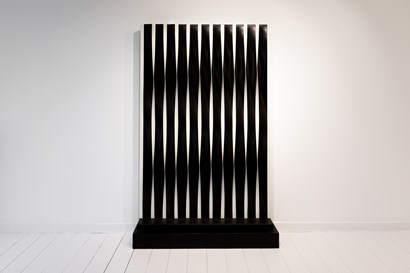
Edouard Simoens Gallery
walter leblanc
Walter Leblanc (Antwerp 1932-1986 Silly) Torsions, 1977-1978 Black and white enamelled steel sculpture 200 x 130 cm Provenance: Walter & Nicole Leblanc Foundation; private collection; André Simoens Collection Literature: Linea Catalogue raisonné, 1997, Ludion, Brussels, CR 1271, p. 282 Exhibitions: Brussels, Tecno, Walter Leblanc Integratie, 1983; Gent, Floraliapaleis, Linea ’83, 1983
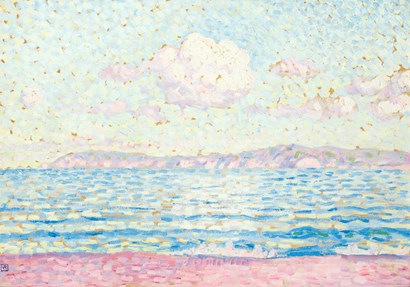
Galerie Raf Van Severen
théo van rysselberghe
Théo Van Rysselberghe (Belgium, Ghent 1862-1926 Le Lavandou, France) Ile du Levant, circa 1904 Oil on panel 30 x 41.4 cm Signed with monogram bottom left Provenance: Foundation Catherine Gide; private collection, Brussels Literature: Feltkamp, 2003, réf. 1924-034, p. 441; Catalogue de l'exposition, Bruxelles, La Haye, 2006, p. 258; Théo Van Rysselberghe, l'instant sublimé, Museé de Lodève, 2012, p. 99; Théo Van Rysselberghe, Intime, 2005, p.65; Théo Van Rysselberghe, Bozar Books by Fonds Mercator & Palais Des Beaux-Arts, Belgian Art Research Institute, 2005, p. 229 Exhibitions: 2005, TVR, Intime, Espace Culturel, Le Lavandou, n° 37; 2006, Brussels, La Haye, without number, p. 229
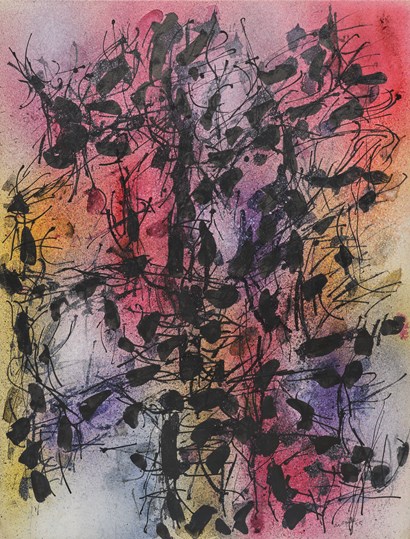
Alexis Lartigue
jean-paul riopelle
Jean-Paul Riopelle (Montreal 1923-2002 Saint-Antoine-de-l'Isle-aux-Grues) Untitled, 1955 Watercolour and ink on paper 64 x 49 cm Signed lower right 'Riopelle 55' Provenance: Claude Duthuit private collection Literature: Catalogue raisonné Jean Paul Riopelle, tome 2, 1954-1959, p. 368
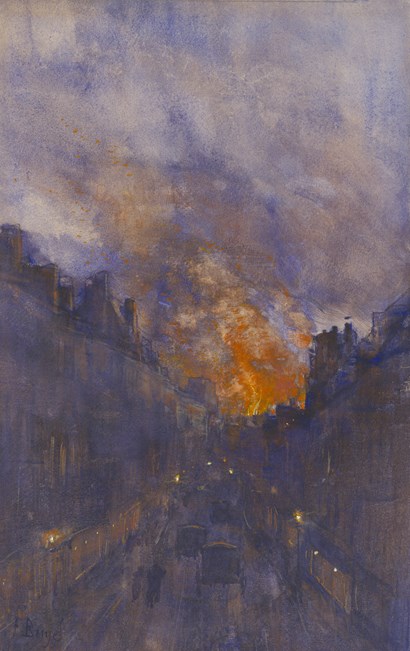
Thomas Deprez Fine Arts
franz binjé
Franz Binjé (Liège 1835-1900 Brussels) Le feu, circa 1894 Watercolour and gouache on paper 42 x 27.5 cm Signed l.l.: 'F. Binjé'. Provenance: private collection, Belgium Exhibitions: Exposition Universelle des Beaux-Arts, section Société Royale belge des Aquarellistes, Antwerp, World Fair, 1894, cat. nr. 699, as: 'Le feu'; Internationale Kunst-Ausstellung, Berlin, World Fair, 1896, Gemälde cat. nr. 228, as: 'Das Feuer. Aquarell.'
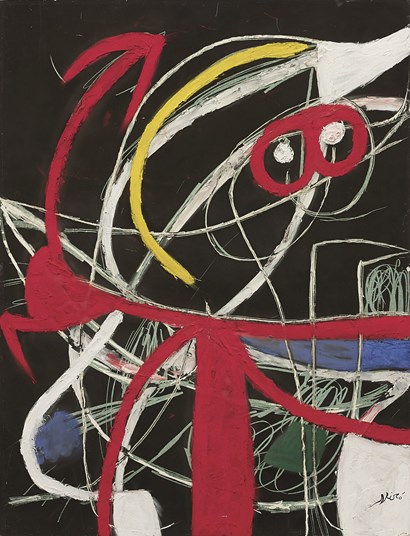
Galerie de la Béraudière
joan miró
Joan Miró (Barcelona 1893-1983 Palma de Majorque) Femme, oiseaux, 1976 Oil, gouache and oil stick on scratched board 65.1 x 50.2 cm Signed lower right 'Miró' Signed, dated and titled on the reverse: MIRÓ., 20/IV/76., Femme, oiseaux Provenance: estate of Joan Miró; Sotheby's, Madrid, 42 works by Joan Miró, 9 December 1986, lot 4 (in aid of the Fundaciò Pilar i Joan Miró, Palma de Mallorca); Quitana Fine Arts, New York; Ramis Barquet Gallery, Mexico City; private collection; Christie's, New York, 9 November 2000, lot 460; Waddington Galleries, London; private collection, Portugal (acquired from the above in 2004); Phillips, New York, 8 November 2015, lot 14; private collection, Europe Literature: Jacques Dupin, Ariane Lelong, Joan Miró, Catalogue raisonné. Paintings, vol. VI: 1976-1981, Paris, Gallery Lelong and the Miró Succession, 2004, ill. n° 1737, p. 49 Exhibitions: 2018, Brussels, Galerie de la Béraudière, Calder, Miró et leurs rencontres parisiennes; 2017, Brussels, Galerie de la Béraudière, La figure animalière; 2016, Brussels, Galerie de la Béraudière, Chefs-d'oeuvre de la galerie et Surréalisme In Woman, Birds, Joan Miró unfolds a free and vibrant universe, where colour and line become forces in motion. Against a deep black background, reds, yellows and whites burst forth with an almost musical intensity. The artist condenses the essence of his language into this work: the spontaneity of gesture, the simplicity of form and the poetry of symbolism. The woman and the bird, emblematic motifs in his work, merge into a space that is both controlled and spontaneous. Created at the end of his life, this composition expresses the supreme freedom of an artist at the height of his powers.

Galerie Alexis Pentcheff
maurice utrillo
Maurice Utrillo (Paris 1883-1955 Dax) Belle Gabrielle, Montmartre, circa 1912-1914 Oil and gesso on cardboard mounted on panel, signed lower right 41 x 55.5 cm Provenance: London, Christie’s sale, 23 June 2004, lot n° 267; European private collection; Galerie Alexis Pentcheff; private collection, France. Literature: Jean Fabris and Cédric Paillier, L’œuvre complet de Maurice Utrillo, Paris, 2009, repr. n° 332, p. 396; Maurice Utrillo, exhibition catalogue, Tokyo, Seiji Togo Memorial Sompo Japan Museum of Art, 2010, n° 1, p. 142 (ill. in colour in the section 'Works reproduced as archives') Exhibitions: Centenary of the Birth of Maurice Utrillo, Musée Jacquemart-André, Paris, May-August 1983, no. 13 (travelling exhibition to Liège, Musée Saint-Georges, and to Lille, Fondation Septentrion in Marcq-en-Barœul, until 15 January 1984); Maurice Utrillo, Tokyo, then Osaka, Kyoto, and Yamaguchi, Japan, 1 November 1985-5 May 1986, n° 17 (ill. cat. in colour); Maurice Utrillo: Solitude Urbaine, Galerie Alexis Pentcheff, Marseille, 22 September-4 November 2017, n° 3 (ill. cat. in colour)
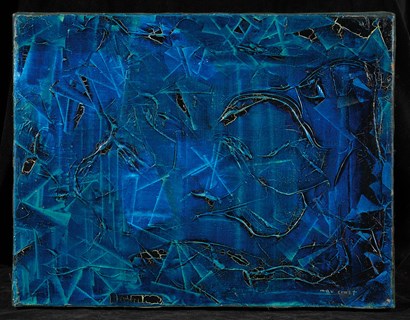
Beck & Eggeling International Fine Art
max ernst
Max Ernst (Brühl 1891-1976 Paris) Un Caprice de Neptune, 1959 Oil on canvas 27 x 35 cm Signed lower right 'max ernst' Provenance: Paolo Marinotti; Lawrence Rubin Greenberg Van Doren Fine Art, New York; private collection, Germany Literature: W. Spies, S. and G. Metgen: Max Ernst. Oeuvre-Katalog, Werke 1954-1963, Cologne, 1998, p. 194, n° 3425 (ill.) Exhibitions: 1961, June-July, Paris, Max Ernst sculptés, Galerie au Pont des Art Weill; 1966, 17 June-2 October, Venice, Max Ernst, Oltre la pittura, Palazzo Grassi, cat. n° 7 (ill.); 1979, Munich, Max Ernst, Retrospektiv, Haus der Kunst, cat. n° 296, ill. III (colour ill. n° 30, ill. 331)

Gilden's Art Gallery
Gino Severini (Italy, Cortona 1883-1966 Paris, France) The dancer, 1959 Tempera painting on wove paper 39.5 x 28.5 cm Signed lower right 'G. Severini' and dedicated in pencil ‘al caro vecchio amico Raffaele Carrieri, affectuoso riccordi di Gino Severini’ [to a dear old friend Raffaelle Carrieri, with affectionate memories, Gino Severini] in the lower right corner The work comes with a photo-certificate of authenticity by Romana Severini Brunori dated 13 May 2025 Provenance: the celebrated poet Raffaele Carrieri (1905-1984); private collection, Milan

N. Vrouyr
Kinheim rug Dutch rug produced in the workshops of Kinheim (Beverwijk), circa 1930, after 1926 Handknotted wool 530 x 405 cm Signed at the back 'KON. KINHEIM BEVERWYK' Provenance: Beverwijk, Holland Kinheim rugs, Beverwijk workshops, Holland (1910-1973) According to the trade register, Hendrik Godefridus Polvliet founded the carpet workshop “Kinheim” on September 1, 1910, at Zeestraat 104 in Beverwijk. The company was originally located on Vondellaan in Beverwijk, which at the time was called Spargielaan. His wife, Mrs. C.M. Polvliet–Van Hoogstraaten (1883–1966), had already started the handwoven carpet workshop “Kinheim” there in 1909. At first, carpets were woven by hand on a small scale. The couple became interested in carpet weaving during a stay in Morocco, where they lived for some time due to Mr. Polvliet’s health problems. Because of recurring asthma attacks, he had been advised to stay for extended periods in warm, dry climates. During this time, Mrs. Polvliet taught herself knotting and weaving techniques and drew many patterns. Initially, the carpets were sold to family and friends. Orders soon began to pour in, and thanks to Mrs. Polvliet–Van Hoogstraaten’s skill, the business grew rapidly. After just a year, in 1911, it moved to Zeestraat and employed about twelve girls. A major commission for 15 carpets for the Peace Palace in 1913 required a larger workshop. The couple had a 144-meter-long wooden workshop built behind their house at Zeestraat 104. This made it possible to weave large hand-knotted carpets behind the residence. Within ten years, the company was well known throughout the Netherlands for its quality and artistic originality. Their own designs, inspired by Oriental motifs, quickly found their way into ships, palaces, city halls, and council chambers. On May 19, 1926, the company was granted the title “Royal.” The founder did not live to see this honor, as he had died on June 17, 1923. His widow, Cornelia Maartina Polvliet–Van Hoogstraaten, continued the business under the new name “Royal Handwoven Carpet Workshop Kinheim.” In addition to private commissions, the company produced many carpets for Dutch passenger ships, such as the Johan de Witt (designed by Lion Cachet), the Nieuw Amsterdam, and many others. Municipal and provincial governments also commissioned important works. For instance, Kinheim carpets can be found in the council chamber of Amsterdam and in the council houses of Den Bosch, De Bilt, Enschede, Uithoorn, and Beverwijk, as well as in the provincial government buildings of Maastricht and Haarlem. In the latter, stair runners designed by Jo de Jong are among the works. Carpets were also supplied to offices such as those of the Netherlands Trading Society and the Shipping House. Highlights for the workshop included commissions from the Royal House. Kinheim made a dining room carpet for Soestdijk Palace designed by Mrs. Brom-Fischer and carpeting for the royal yacht Piet Hein. Notably, the Sultan of Deli (in 1938) and the Shah of Persia also placed orders with Kinheim. After an initial period of prosperity, the workshop suffered a setback due to World War I, but it flourished again in the 1920s. At that time, the many commissions provided employment for around 60 women and girls. During the economic crisis of the 1930s, the company survived by focusing on simpler techniques, producing the cheaper “konkit carpet,” woven with coarse knots and undyed materials. During World War II, the business, which had in 1941 passed into the hands of Mr. Keizer from Hilversum, came to a standstill. Work resumed after 1945 under the leadership of Mr. and Mrs. Mastenbroek. Many large commissions were once again completed for government buildings, ships, and businesses. The company then employed between 30 and 40 women on average, sometimes as many as 60. Later, changes in taste and economic conditions, particularly the decline in orders from shipping companies, caused a sharp drop in demand for hand-knotted carpets made with special patterns. These and even plain rugs were increasingly replaced by much cheaper, machine-made carpets. Kinheim completed its final commission in early 1973, and in April of that year, the Beverwijk workshop closed. Well-known designers who worked for Kinheim included Jac. van den Bosch, C.A. Lion Cachet, Theo Nieuwenhuis, and Dirk Verstraten. Kinheim was the only company in the Netherlands where carpets were knotted following the classical Oriental method. Each carpet required a vast number of working hours. The size of the carpet determined how many girls worked on it: a narrow runner or cushion cover was made by one girl, but a large carpet could involve 8 to 10 workers. The women ranged in age from 15 to 60. A carpet with 40 knots per square centimeter and a size of 2 by 3 meters contained about two and a half million knots. A skilled knotter made 5,000 to 8,000 knots a day, meaning that such a carpet required around 350 working days. The early carpets of the Kinheim Carpet Workshop (before 1926) were marked on the back with the words “Kinheim” and “Beverwijk,” along with an image of a swastika. After the company received the “Royal” title in 1926, the swastika mark was replaced by a crown or the abbreviation ‘KON.’.

Victor Werner
carl johan bonnesen
Carl Johan Bonnesen (Aalborg 1868-1933 Copenhagen) African elephant, 1924 Bronze with green patina H 54 x W 78 x D 34 cm Signed and dated CARL J. BONNESEN 1924 Provenance: Professor Karl Meyer, board member of Villadsens Fabrikker; donated Nov. 9th, 1932, to the company director Christian Villadsen and his wife Ingeborg (as inscribed on the base); gifted by Christian Villadsen’s grandson to the previous owner
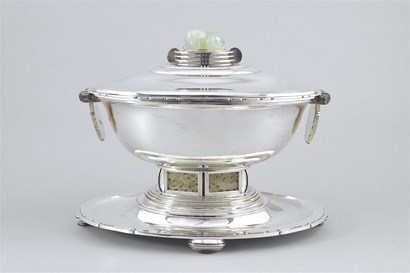
Francis Janssens van der Maelen
Silver box in jade Paris, Art Deco Sterling silver, jade W 35 cm - 4400 gr (total weight) Bears retailer's stamp, Boin-Taburet and maker's mark, Henry & Fils Boin-Taburet were formed in 1873 and quickly established themselves as one of Pairs's most noteworthy makers & retailers, winning a Gold medal at the 1889 Paris Exposition Universelle. Arguably their most distinctive work married silver and silver-gilt with other materials including porcelain, marble, and in the case of this stunning Art Deco tureen, jade. Jade was seemingly a less often used material - the only other piece found with a similarly carved jade element was a box that fetched an incredible amount at auction in 2012.
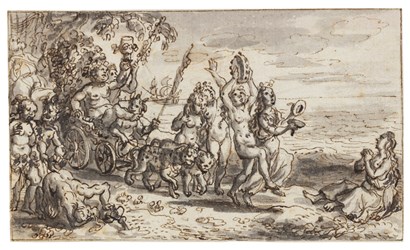
Galerie Lowet de Wotrenge
david vinckboons (mechelen 1576 - 1629 amsterdam)
David Vinckboons (Mechelen 1576-1629 Amsterdam) The Triumph of Bacchus Pen and brown ink and grey wash over black chalk, within brown ink framing lines on laid paper 68 x 114 mm Provenance: Dr. Einar Perman (1893-1976), Stockholm; by descent to the previous owners; sale, New York, Sotheby's, 31 January 2024, lot 104 Literature: Laren, Singer Museum, Oude Tekeningen uit de Nederlanden. Verzameling Prof. E. Perman, Stockholm, 1962, cat. n° 121 (as Adriaen van de Venne)
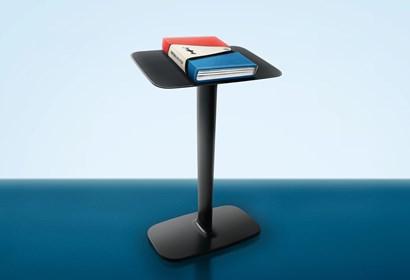
TASCHEN
marc newson
Marc Newson (Australia, Sydney 1963) America’s Cup This limited edition unfurls the story of America’s Cup and celebrates its skippers, owners, defenders, and challengers. Packed with previously untold tales and unseen photographs, it features a case designed by Marc Newson, crafted from cotton sailcloth, and a custom-made closure by Louis Vuitton, the official partner of the 37th America's Cup. Copies 1-175 come with a numbered carbon fiber bookstand also designed by Newson.

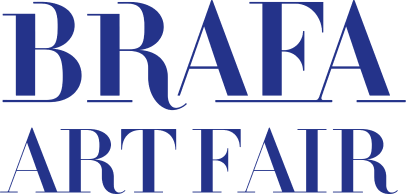



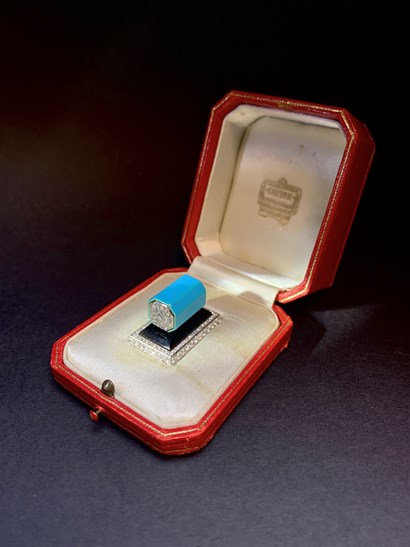





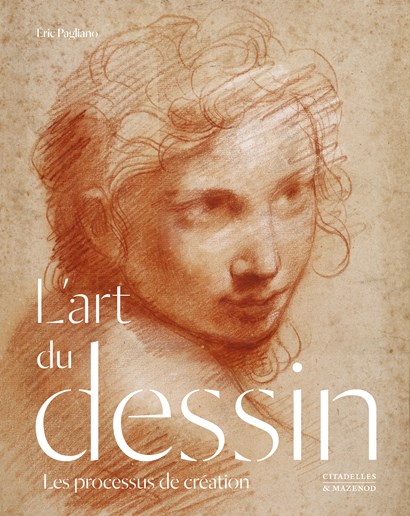
_LéaBelooussovitch_T638926698712577032.jpg?width=410&height=2000&qlt=90&scale=both&mode=max&format=jpeg)


